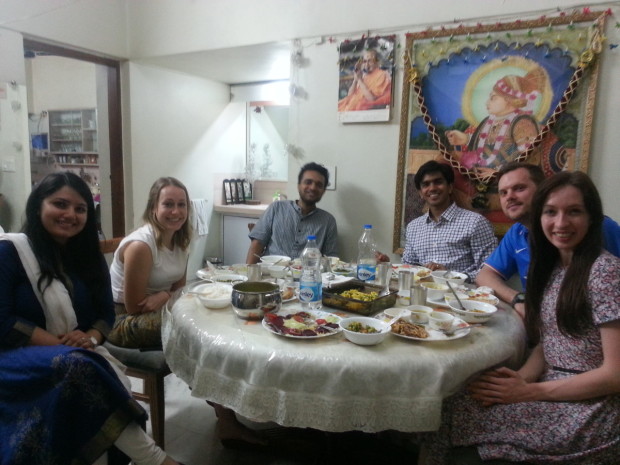AHMEDABAD—The family filtered into a small room. The grandmother stood before a picture of Swaminarayan, with a sacred lamp, performing the evening aarti. She whispered words of prayer, moving the sacred lamp back and forth, and passing it around. The walls of the home shrine were covered in photos of various manifestations of gods and the family’s guru, Pramukh Swami Maharaj, leader of the BAPS Swaminarayan Sanstha. Several members of the family took the lamp, placing their cupped hands over the flame and touching the tops of their heads, symbolically purifying themselves.
We dined at a multi-generation Swaminarayan Hindu home in Northern Ahmedabad, with ten family members, including cousins, grandparents and a newly-wed couple, Anand and Minali Patel. Our first interaction with the family was through a special ritual moment. We were greeted with the evening prayer rituals performed in the Patel’s home. It was their way of receiving a blessing that is part of the evening aarti. They gather at the shrine, a sacred space set apart to honor and worship God.
Earlier that evening, on the ride to the Patel family home from the hotel, Anand discussed the main industries of Gujarat, including the strong textile production in the region. Two generations ago, Anand’s grandfather built tables for sewing machines. The business grew and today his family makes tables for sewing machines of all sizes. In fact, as an act of seva – or service performed in devotion to God – Anand’s family said they make donations from their business. These donations include supplying resources for village classes for those who may want to learn how to work in the textile industry to supplement their family’s income.
The meal began with an appetizer, a blend of tomato and fresh herbs from their garden. The main dish included a sweet yellow whipped yogurt with a mix of vegetables, curry and chapatis. They returned with crispy crackers, roasted peppers, and rice. All cooked by hand. True to their tenets, however, there were no flavors of onion or garlic, foods prohibited for many Vaishnavas and specifically Swaminarayan devotees.
The conversation moved from food to relationships. Anand and Minali, our hosts, met through a matchmaker, culminating in their eventual arranged marriage. They joked about their year-long courtship and how they see themselves as complete opposites.
But their care for one another was apparent. When asked about their relationship, she teased her husband, confessing that he treats her well. “If I even sneeze once, he’ll ask if I’m ok,” Minali said. She prepared the plates in the kitchen, bringing out dish after dish of Indian cuisine until our stomachs were as full as the kitchen table. She later joined us at the table, joining in on the conversation.
The discussion heightened to a friendly debate about the relationship between politics and the caste system. Anand shared a perspective we had not yet considered. Caste is less about religion, he asserted, and more about economic class. While the narrative of religious and caste minorities can be a sobering one, reverse discrimination affects the majority. Indian policy seemed to be sacrificing one version of a meritocracy for another.

Hosts Minali (far left) and Anand Patel (third from right) invited India Yatra reporters and Professor Trivedi into their house for dinner. Photo by Sam Steinberger.
The conversation sparked thoughts about a system that we compared to affirmative action in the U.S. or initiatives designed to right historical injustices. In this case, these injustices stemmed from the remaining traces of the caste system. India’s progressive attempt to offset caste-based inequality offers reservations to caste and religious minorities, giving them a leg up in educational and career opportunities. We were shocked to hear that some people in India would go so far as to claim a lower caste standing, in order to capitalize off the caste-based quotas that India’s universities must fill. Throwing religion into the mix further complicated the topic as we learned from Rachel’s own reporting on Christian schools within India. She found that religions that do not recognize the caste system, most prominently Christianity and Islam, attract converts from the lower caste–Dalits who seek reprieve from discrimination. However, legislation in past years has failed to offer rights to Christian and Islam Dalits, who remain subject to discrimination beyond the churchhouse.
Politics and religion converged again in our conversation about the rise of the BJP and the Hindu right within India. We asked our host what he thought about the BJP’s attempt to revamp Hindu nationalism. Anand told us that he actually observed a lack of patriotism within India. He said that many leave their homeland and take out loans to attend universities in the U.S. Yogi pressed him on this point. Does this fact correspond with a lack of patriotism? Anand viewed this “brain drain” as a lack of loyalty to India.
By this time we were seated on chairs on the front porch, relaxing in the warm evening air.
We presented the gifts we brought – a box of incense, chocolate, and a $2 bill – a gift usually given as a token of good luck in the US. Our hosts then rushed upstairs and returned with gifts for each of us. It was the perfect dinner—an exchange of ideas, food, and hospitality.